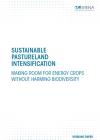

-
-
IRENA (2018), Sustainable pastureland intensification: Making room for energy crops without harming biodiversity, International Renewable Energy Agency (IRENA), Abu Dhabi
Copied
/-/media/Files/IRENA/Agency/Publication/2019/Mar/IRENA_Sustainable_pastureland_2019.pdf
Copied
Sustainable pastureland intensification: Making room for energy crops without harming biodiversity
Newsletter
Biofuels are an essential renewable energy resource, with 40% (90 exajoules) of renewable energy resources projected to come from biofuel sources by 2050. In order to meet these projected energetic demands, biofuel production must be increased from the current annual biofuel yield of 50 exajoules.
Sustainable intensification of pastureland, or the increase of livestock yield in kilogrammes per hectare, is a key approach to making more land available for these bioenergy crops, like high-yielding grasses and short-rotation coppice wood, without incurring the carbon debt associated with conversion of farmland from forest. However, pastureland intensification is often criticised as a potential threat to pastureland biodiversity – there are cases of unsustainable intensification of pastureland leading to ecological degradation.
This working paper reviews approaches to sustainable intensification of pastureland that have had a neutral or positive effect on biodiversity of the affected areas, and how some of these approaches have been implemented in several successful case studies.




